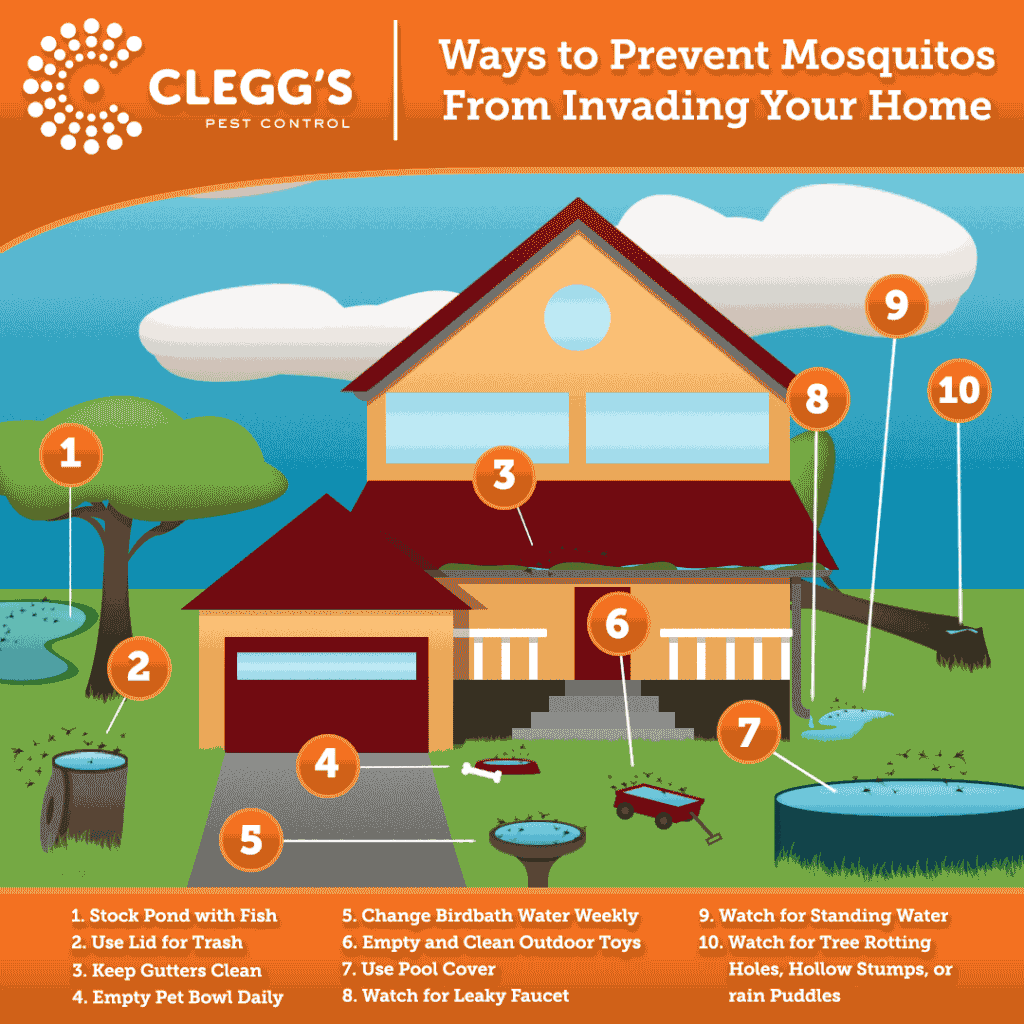Mosquito Control Guide: Keep those bloodsuckers away
How are we so good at Mosquito Control? Studying the habits and understanding the life of a mosquito allows us to know where it lives, who it preys on, how it moves, what it looks like in all stages of life, and most importantly, how to get rid of it effectively.
That is how we provide the best mosquito control services at Clegg’s. In this guide, we will show you some of the ways that you can be on the lookout for what mosquito infestation looks like and how we can help you control it. If you have professionals like Clegg’s on your side, the mosquitoes have no chance of ruining a beautiful summer evening!
Where do mosquitoes live?
When you’re outside on a warm summer evening and the sun is beginning to set, everything seems perfect until…buzzz! You start swatting at mosquitoes that you can see floating around you and continuously brush your arms and legs to make sure that none have landed on you for a snack. Where did all these mosquitoes come from? You were enjoying the day outside and all of a sudden you get jumped when the sun goes down.
Mosquitoes are nocturnal creatures and they look for a host to feed on at night. So where are they during the day, or even the winter months when it is too cold for them?
During the day, most mosquito species find a spot to hide out before they start their hunt in the evening. They will usually look for dense brush and tall grass to hide in. Some will even find a hole in the ground or in a tree to sit inactively during the day.
Mosquitoes have the ability to remain dormant throughout the cold months of the year. They don’t migrate for the winter like birds do and they don’t just die. Mosquitoes can go dormant as adults and as eggs, and they can remain in this state for several months at a time.
Knowing the natural habitat of a mosquito is a vital part in knowing how to effectively exterminate them. Clegg’s professionals know what kinds of places to look for mosquitoes and what signs to look for when finding where a mosquito lives. This is why we’re so good at mosquito control.
Read the full article here: Where do mosquitoes live?

How long do mosquitoes live?
What does a mosquito do in the duration of their time on earth and how long is that exactly? Does a mosquito live for days, months, or even years at a time? These questions are important to know when it comes to mosquito control. The lifespan of mosquitoes depend on several things like its species, its sex, and the time of year.
The lifecycle of a mosquito has 4 different stages that they go through. These stages include:
- The Egg stage
- The Larvae stage
- The Pupa stage
- The Adult stage
In each of these four stages, the mosquito takes a different physical form. Each stage can also last different lengths of time. Some mosquito species spend half of their life in the first three stages, then die after reproducing in the adult stage. This can last as little as one month for a mosquito. Other mosquitoes can live six months and more because of their ability to survive through the winter to reproduce the next spring.
Mosquitoes can survive many months as both eggs and adults. If a mosquito is in the egg stage when it begins to get cold, the mosquito will not transition into the next phase of life until the next warm season rolls around.
Mosquitoes can also survive through long winters as adults because they are able to go into a state of hibernation. It is mostly female mosquitoes that do so because they are waiting to lay their eggs in the warm seasons.
Male mosquitoes on the other hand do not live very long at all. The males will feed on the nectar of flowers in the summer and drop dead after only a few weeks in the summer months. He will fertilize a female’s eggs, then die shortly after.
Read the full article: How long do mosquitoes live?
What attracts mosquitoes?
There are some reasons why mosquitoes would be more likely to pick your yard as a good place to call home. There are also reasons that they decide to choose you for their evening snack. So what is the mission of a tiny mosquito buzzing around your yard? There has to be something that is attracting them to the area.
There are two things that attract mosquitoes to any given area and they are food and a place to breed.
In the life of a mosquito, the only thing that motivates them to live is reproduction. It is in their nature to look for food and shelter in order to reproduce and continue their species.
That being said, there are several senses that mosquitoes have to help them identify food sources and a home.
Food
Mosquitoes are known for their need to feed on blood as they leave behind an itchy whelp on the skin of their host. Female mosquitoes are the ones that feed on blood because the eggs she carries require the nutrients in blood to develop.
So how do mosquitoes know that they are landing on a host to feed on rather than any other object like a tree or rock? They use their incredible sense of smell and eyesight to target a meal.
Breeding Grounds
A mosquito will find a place to lay its eggs after it has nourished them with blood. Since the first several developmental stages of a mosquito’s life require it to be in water, that is where the female adult mosquito will lay her eggs. The mosquito requires a stagnant pool of water to place the next generation of these pests. If you have any water sitting around your yard, you better watch out during the mosquito breeding season.
Read the full article: What attracts mosquitoes
How to kill mosquito Larvae?
Mosquito Larvae is the stage in a mosquito’s life in which they are most vulnerable and can be exterminated effectively. It is important to know how to locate mosquitoes when they are in this stage of life in order to get rid of them once and for all.
There are several key things to know about the Larvae stage of a mosquito in order to exterminate them effectively. These things include:
- What they look like
- Typical locations you can find them
- How to kill them effectively
- If there is a feasible solution for you to kill them naturally
You could have the best insecticide on the planet that kills only mosquito larvae and nothing else, but it will be worthless if you do not know where to put it. You first need to know what you’re hunting for and how to identify your target before you can exterminate it.
Our experts at Clegg’s are professional bug hunters as they will know exactly what to look for and how to take care of the situation. Our job as pest control specialists is not just spraying bugs. There is a skill that is required to track pests in order to exterminate them. We know how mosquito larvae act in nature and where to find them. Killing these pests before they can even fly gives us a huge advantage over them.
Read the full article here: How to Kill Mosquito Larvae
Why hire a professional like Clegg’s?
Hiring a professional to help with your mosquito management will not only save you time and money in the long run but it is also a much safer solution for you and your family. At Clegg’s, we will get it done right the first time. You won’t have to stress about finding the best solution or products. Our experienced exterminators will quickly identify and treat your problems, saving you time. Store bought chemicals for pest control contain many ingredients that aren’t always safe for you or your family. If they are not applied correctly, you could potentially harm yourself, children, or pets. Professionals are just that, experienced and educated in the process and by hiring one, most risk is removed for you. If you have problems with mosquitoes at your home, contact our Clegg’s pest control heroes and let us get to work returning your peace of mind today!
Mosquito Control Service Areas
Clegg’s Pest Control is proud to provide local mosquito control solutions across North Carolina, including these areas:
- Mosquito control in Asheville, NC
- Mosquito control in Charlotte, NC
- Mosquito control in Clinton, NC
- Mosquito control in Durham, NC
- Mosquito control in Fayetteville, NC
- Mosquito control in Greenville, NC
- Mosquito Control in Kernersville, NC
- Mosquito control in Morehead City, NC
- Mosquito control in New Bern, NC
- Mosquito control in Raleigh, NC
- Mosquito control in Smithfield, NC
- Mosquito control in Southport, NC
- Mosquito Control in Wilmington, NC

